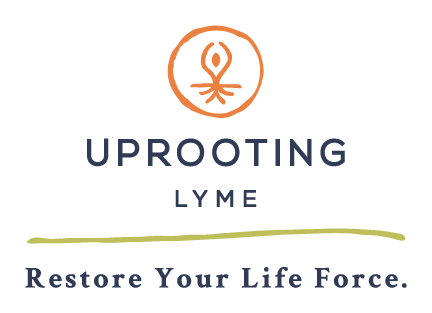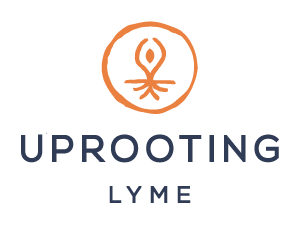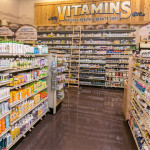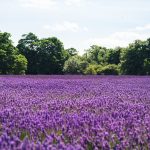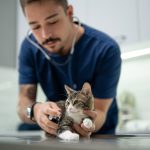
Herbal Medicine for Bartonella Infection: A Case Study
Reggie is a 44 year old man who currently lives in California. At our first meeting, he reported “feeling terrible.” Thinking back, he remembered growing up in New Jersey and being outdoors all the time. He experienced a major febrile illness at age 16, but it was seen as a bad flu and no diagnosis or treatment was pursued.
As a young man in his 20’s Reggie developed hypertension (for which he’s been on medication ever since), chronic ear infections, environmental allergies, and food intolerances. He has a long history (approximately 20 years) of gut and food sensitivity, particularly to dairy and acidic foods. He has also suffered from chronic sinusitis off and on since this time.
Gradually over the years Reggie developed more symptoms, particularly brain fog, fatigue, sweating, body pain and inflammation, and blurry vision in the left eye, Eventually, in 2018, he was diagnosed with chronic neurological Lyme and Bartonella infection, as well as central serous retinopathy (CSR – an eye condition associated with stress, hypertension, and auto-immune conditions).
After his diagnosis in 2018 he was given numerous courses of antibiotics, including IV Rocephin. Some of his symptoms improved thanks to these treatments, but not fully. Brain fog, poor memory, inability to focus, and blurred vision continued to plague him.
In the fall of 2022 following a minor surgery, the brain fog suddenly became severe to the point that he needed to take time off from his work as an architect. He was prescribed a medication for ADHD, which did help his concentration.
He also developed spinal pain and tightness which ran from his neck down into the lower back. He tried cortisone shots for this, but they did not bring any relief.
His primary complaints at the time we first spoke were:
- Psychiatric – These symptoms were the hardest for him to talk about and put into words. He described random outbursts of anger and rage; irritability; even suicidal ideations, clearly “not feeling like himself,” an inability to tolerate stress, and cognitive dysfunction affecting his memory and ability to focus and think through problems;
- Neck, upper, and lower back spinal pain, tightness and sense of swelling;
- Blurred vision of the left eye (CSR), and high-pitched tinnitus in both ears;
- Energy was very up and down; since he returned to work, energy was much more challenging to manage;
- Tenderness at the wrists, ankles and various other joints, and generalized muscle tension;
- Restless leg and full body jerking and tremors during sleep;
- Frequent, urgent urination;
- Loose stool and weak digestion;
- Migraine-type headaches;
He felt he was getting worse, and he was scared. Yet he did not want to return to a pharmaceutical antibiotic regimen because he doubted whether more of that type of treatment would lead to a full recovery. He was also concerned that he might further harm his already delicate gut and make his health worse.
More than anything, he wanted to get better. Reggie ate a healthy well-rounded diet and liked to exercise (although he hadn’t been able to lately). He valued his health and wanted to feel good in his body and be a productive, high functioning father, husband and architect. At the end of our initial meeting, I gave him the following feedback regarding his case.
Assessment & Initial Treatment Strategies:
Growing up in an area that is a known hotbed of Lyme disease, Reggie was a top candidate for having long-term Lyme and other tick-borne infection that went undiagnosed for many years. In his 20’s, his immune system and autonomic nervous system had started to dysregulate – showing signs of both immune deficiency on the one hand (chronic infections), and hyperactivity on the other (allergies and food sensitivities).
This is a vicious cycle as the antibiotics prescribed to treat the ear and sinus infections can lead to greater dysbiosis, leaky gut, and the development of inflammatory reactions to foods. Inflammation increases and becomes chronic and systemic. Over time classic symptoms of chronic infection and inflammation appear – fatigue, pain, and brain fog. In addition, localized tissue damage occurs where there is vulnerability – in Reggie’s case in the left eye.
The diagnosis of Lyme disease and Bartonella was pivotal in Reggie getting the treatment he needed. The pharmaceutical antibiotic regimen cleared a significant amount of the infections, as evidenced by his symptoms improving. However, some portion of the bacterial populations remained, latent and more resistant to the same antibiotics.
Minor surgeries have been known to cause re-activation of latent infection, whether due to disruption of colonies due to the surgery, or because the immune system is distracted with healing and the latent infections take advantage of the opportunity.
Given Reggie’s willingness to commit to a lifestyle that would support healing naturally, I recommended we try treating with herbs and holistic methods first and keep the option of a return to pharmaceutical antibiotics on the backburner for now.
I felt his system would benefit from a multi-pronged approach that included:
1. Detoxification – to aid his liver and other organs to get rid of the infectious and toxic waste that was burdening and inflaming his body.
2. Gut repair and a healing food regimen – because food and digestion can be a major source of inflammation and symptom generation in other parts of the body; healing the gut and committing to a personalized anti-inflammatory diet can have a huge impact in supporting reversal of systemic inflammation.
3. Botanical antimicrobials – herbs and essential oils are among the most potent antimicrobials available; what’s more, they are non-toxic, safe for long-term use, and
their complex chemistry makes it much harder for the microbes to form resistance against them.
4. Treatment of biofilm and fibrin nesting sites – this facet of treatment may have been overlooked in past treatment, yet it is crucial for lasting recovery from chronic
infections.
Treatment Phase 1:
We discussed some different healing diets, and he chose to adopt the Wahl’s diet as he had some familiarity and resources for it. The Wahl’s diet is a paleo diet that was designed to support healing from chronic auto-immune conditions. Having a clear boundary regarding what to eat and what not to eat was helpful for him to adhere and be successful with these changes.
Living with a municipal water system, I recommended drinking 40-60 ounces of the best quality spring water he could obtain. For him this involved home delivery of a well-vetted local spring water delivery company. In addition, I advised adding 1 teaspoon of a saturated salt solution per 20 oz. water. Adding an unrefined saturated salt solution to spring water supports cellular hydration and water metabolism. You can learn more about salt sole and how to make it here.
In addition, we started him on 3 foundational remedies:
- A blend of 2 liposomal essential oil remedies, Spiro Upward (which targets Lyme-Borreliosis) and Lucid (which targets Bartonella). These formulas were combined, and he spent the first month slowly titrating the dosage from 1 teaspoon / 2x / day up to the typical top dose of 2 Tablespoons / 2x / day (taken in 1 ounce of coconut or almond milk if needed, 30 minutes or more away from food).
In my clinical experience, herbs taken as tinctures, teas or in capsules are usually not strong enough by themselves to eradicate chronic infections fully. However, when
herbs are combined with essential oil blends (taken liposomally to prevent them from harming the mucous membranes and for easier absorption into the cells), this
combination is often enough to eradicate entrenched infections. - I crafted a personalized herbal medicinal brew (decoction) based on the formula Bupleurum Liver Cleanse, a liver detox support formula, with some additions for specific
symptoms and antimicrobial support.
His formula contained:
- Bupleurum, Chinese skullcap, and moneywort to support liver detoxification and reduce headaches and overall inflammation;
- Cryptolepis and Japanese knotweed to heighten antimicrobial activity against Lyme and Bartonella;
- Isatis and ningpo figwort to support lymph decongestion and help alleviate spinal swelling;
- Sophora root and shepherd’s purse to help neutralize endotoxins, reverse the trend towards auto-immunity, and reduce inflammation;
- Additionally, celosia seed and pipewort flower were used as special herbs that clear inflammatory conditions of the eyes.
- Because I felt that Bartonella was the primary infection that was driving his symptoms, we also started A-Bart tincture from Byron White to provide additional antimicrobial focus against Bartonella infection. He was directed to start at 1 drop / 2x / day in 1 oz. water, and every 3 days increase by 1 drop / 2x / day (with a max dose of 15 drops / 2x /day).
I also recommended that he re-do labs for tick-borne infections since it had been 5 years since he was last diagnosed.
Follow Up After 1 Month
Reggie was taking his titration on the antimicrobials slowly as he was concerned that they might provoke a Herxheimer reaction that would be difficult to manage. He was about half-way through his titration on the liposomal essential oil and Byron White remedies, and he was at the full dose of the Liver Detox tea. He also had committed to the Wahl’s diet and was doing a lot of exercise.
Overall, Reggie reported that he felt he was moving in the right direction. His emotional irascibility which had been at an intensity level of 8-9/10 he now rated at 6/10. He was no longer having suicidal ideations and he was “feeling more himself.” Cognition was more clear and he was better able to accomplish multi-step tasks (“less mental entropy and lethargy”).
His spinal pain and swelling was the same or slightly increased. More than likely this was due to some heightened inflammation due to die-off.
His bowels were more regular and his gut overall felt calmer.
He thought there may be slight improvement in the left eye’s vision and his skin felt healthier with less dryness and itching
The plan was to continue working with the same formulations and work towards titrating up to the top dosages. I also recommended an adrenal glandular supplement to support his energy; lumbrokinase at a low dose to begin to address the biofilm and fibrin nesting sites; and magnesium glycinate to support the muscle tissue and resolve spasm and tension.
Follow Up At Month 3
At this point Reggie was clearly doing much better.
He had had a few more “episodes” in which his psychiatric state became highly distressed, possibly brought on by Herxing, and he recognized how much detoxification helped him move through and overcome these waves of die-off.
His restless legs had decreased at night so sleep was easier and the spinal neck and back pain was “greatly diminished”.
His energy was also much improved to the point that some days his energy levels felt quite normal. He even reported having some “A+” days in which he felt better than he had in 10 years!
It was clear to him that if he strayed from the diet, that resulted in feeling more unwell. He also felt that if he missed a dose of his antimicrobial remedies he would experience more brain fog.
He shared the results of recent bloodwork, which included:
- C4a inflammatory marker was sky-high at 38,832 (0-2830);
- Epstein Barr Virus IgG and nuclear antibody positivity > 8 (0 – 0.8);
- Igenex Lab testing showed:
o Babesia microti Immunoblot was positive for both IgG and IgM;
o Tick-Borne Relapsing Fever IgG was positive;
o Immunoblot for Borrelia IgG showed 4 bands positive; IgM 1 band positive
and 2 indeterminate; the IFA score was 80 (> 40);
o Indeterminate for Bartonella species.
Analysis of Labs:
The elevated C4a is associated with inflammation due to infection, as well as auto-immune illness, chronic fatigue, and allergies. His C4a is quite high, and his system was trending towards auto-immunity and worsening inflammation prior to treatment; however with proper treatment over time we expect this marker to diminish and normalize as his body becomes less inflamed as evidenced by a reduction of symptom intensity.
The Epstein Barr Virus results suggest possible re-activation; at some point we plan to address this with anti-virals and see how the body and symptom picture responds.
The Igenex Labs results were helpful in revealing both Lyme-Borreliosis positivity as well as TBRF. The indeterminate result for Bartonella confirmed its presence, and based on Reggie’s presentation this infection is a major driver of the current illness, confirmed by the positive response to current treatment which is focused primarily on treatment of Bartonella infection.
The positivity for Babesia was helpful to know, as Babesia and Bartonella have overlapping disease mechanisms and can “team up” to make the infections harder to treat than if only one of these infections is present.
Overall, these labs show that we still have long-term treatment ahead of us (in the neighborhood of 1-2 years). However, he could be feeling quite well for much of that time, as
we work consistently towards release the layers of various microbial burden from his system.
With this new knowledge, we added a formula to treat the Babesia infection as well, Liberate, in tincture form.
We also added an essential oil based nasal spray, Old Faithful Nasal Spray, for sinus congestion that was on-going, and had been more pronounced lately.
I modified the herbal detox tea to incorporate herbs to treat Babesia, and alleviate inflammation in the urinary bladder, which was a problematic symptom that had not yet been
adequately addressed.
The new tea formula consisted of:
- Bupleurum, Chinese skullcap, ningpo figwort and moneywort to support liver and lymph detoxification and continue to reduce inflammation in the brain and body;
- Cryptolepis, black walnut hull, and wormwood (sweet annie) were chosen as antimicrobials for the Lyme-Borreliosis, TBRF, Babesia and Bartonella;
- Uva ursi, wild yam, and trichosanthes root were added to reduce inflammation affecting the urinary bladder and support water metabolism.
All other remedies were continued, and the dosage of lumbrokinase was increased to address the Babesia infection and urinary bladder inflammation.
Follow Up At 5 Months + Prognosis
At our most recent meeting, Reggie’s gains continue to hold. He finds his regimen do-able long- term.
The spinal pain is still there, but considerably less severe. His energy level is still somewhat up and down, but it’s far more stable and he is able to cope with the day-to-day stressors of his work and family life without heightened reactivity. He feels stable emotionally.
He reports that his eyes and the CSR is improving – his ability to focus and see color is somewhat better, and the eye’s tissue damage seems to be reducing.
His joints are less tender and muscles carry only minor (a “normal” level of) tension. The urination is less frequent, but still feels urgent. His digestion ranges “from good to
perfect.”
All of this is good news, even as he is facing some stressful life events. We’ll continue to support his detoxification and immune system, his energy and resilience in the face of stress, and encourage him to take care of his body with diet and exercise.
All the while, we will move through eliminating the various layers of infection that are driving the inflammation and health
challenges. We will also persistently break apart the biofilm and fibrin nesting sites that provide shelter for these entrenched infections.
Given his positive response to treatment, we expect that he will eventually make a full recovery, and along the way will become empowered to maintain the best health of his adult life.
